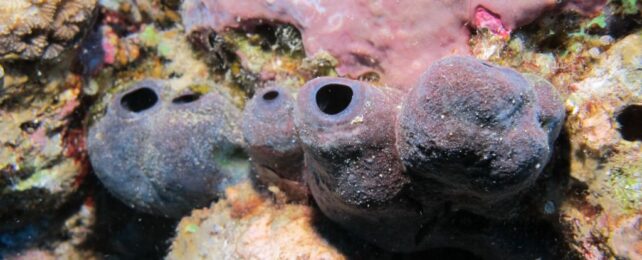Place your adverts here on InfoDig @ low rates; banner ads, sponsored links and guest articles etc. Contact us
 The sea sponge Theonella conica in its natural habitat in the Red Sea. (Shani Shoham)
The sea sponge Theonella conica in its natural habitat in the Red Sea. (Shani Shoham)
It can be a brutal world out there, and the vulnerable sometimes have to turn to creative solutions to ensure their survival.
Take a sea sponge called Theonella conica. This unassuming animal can be found in the Red Sea and Indian Ocean, doing what sponges do, filtering the seawater around them to extract the nutrients within. Anchored in place, with little in the way of active defense, T. conica has evolved a truly fascinating means of survival.
Scientists studying the accumulation of pollutants in the sponge's body found concentrations of a heavy metal called molybdenum that, in other organisms, would be fatal.
"Twenty to thirty years ago, researchers from our lab collected samples of a rare sponge called Theonella conica from the coral reef of Zanzibar in the Indian Ocean and found in them a high concentration of molybdenum," says marine biologist Shani Shoham of Tel Aviv University.
"In my research, I wanted to test whether such high concentrations are also found in this sponge species in the Gulf of Eilat, where it grows at depths of more than 27 meters [88 feet]. Finding the sponge and analyzing its composition I discovered that it contained more molybdenum than any other organism on earth: 46,793 micrograms per gram of dry weight."
We, and other organisms, need some molybdenum. It's an essential trace element that our bodies use to break down things like drugs, toxins, and sulfites. Like many things, though, too much molybdenum is not especially good for us, and even worse for other animals.
So how, and why, T. conica is able to accumulate and hoard so much of the metal was something Shoham and her colleagues wanted to understand.
The answer came in the form of the sponge's bacterial symbionts.
As a sea sponge, T. conica is pretty simple. It has no organs, no tissues, and no nervous system. To function, it relies on symbiotic relationships with other organisms, including bacteria, funguses, algae, and viruses. As much as 40 percent of its body weight consists of symbionts. And before you side-eye, look at your own body. We all need friends.
Symbionts are organisms that live together in a long-term relationship that is beneficial to both (as opposed to, say, a parasitic relationship in which the benefits are markedly one-sided).
One of the most dominant bacteria in T. conica, the researchers found, acts as a sort of detoxifying organ for accumulating heavy metals in the sponge's body. It's called Entotheonella sp., a bacterium found in a few different sponges and known for its ability to produce a wide range of bioactive compounds.
Shoham and her colleagues found globs of material inside Entotheonella sp. that had very high molybdenum content.
Molybdenum is toxic when its concentration is higher than its solubility in water. The bacterium, the researchers believe, collects molybdenum and converts it into safe molybdenum compounds, such as calcium molybdate and sodium molybdate.
"Hoarding more and more molybdenum, the bacteria convert it from its toxic soluble state into a mineral. We are not sure why they do this," Shoham says.
"Perhaps the molybdenum protects the sponge, by announcing: 'I'm toxic! Don't eat me!', and in return for this service the sponge does not eat the bacteria and serves as their host."
The implications suggest a way we can use these sponges and their symbionts – not to extract molybdenum, which would be complicated and likely not worth the effort – but to help deal with pollution. A few years ago, a related sponge, Theonella swinhoei, was found to be similarly accumulating high levels of barium and arsenic.
"In this case, too, Entotheonella was found to be largely responsible for hoarding the metals and turning them into minerals, thereby neutralizing their toxicity," Shoham explains.
"Continued research on the bacteria can prove useful for treating water sources polluted with arsenic, a serious hazard which directly affects the health of 200 million people worldwide."
The research has been published in Science Advances.















 English (US) ·
English (US) ·